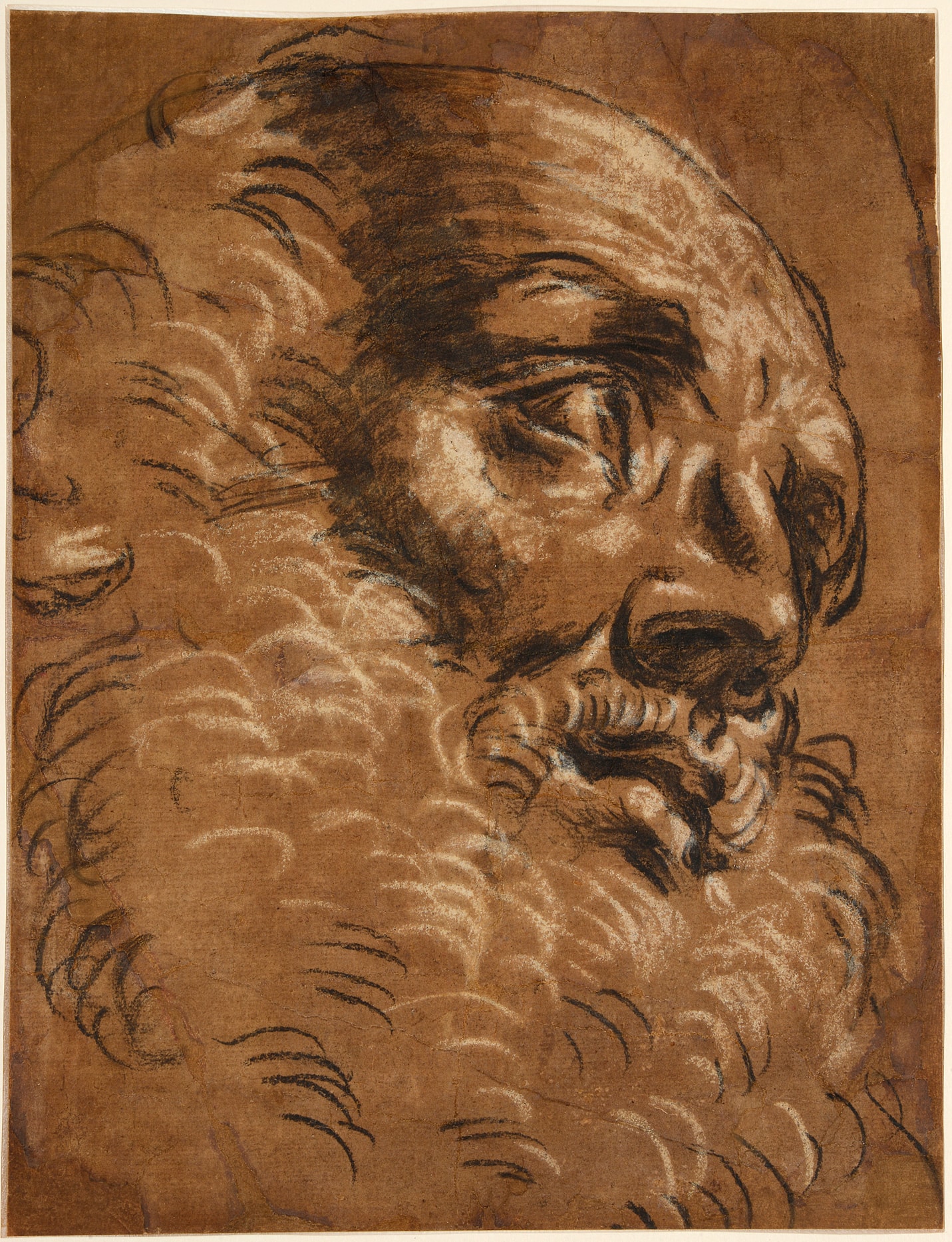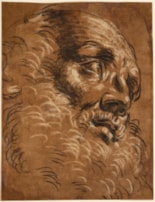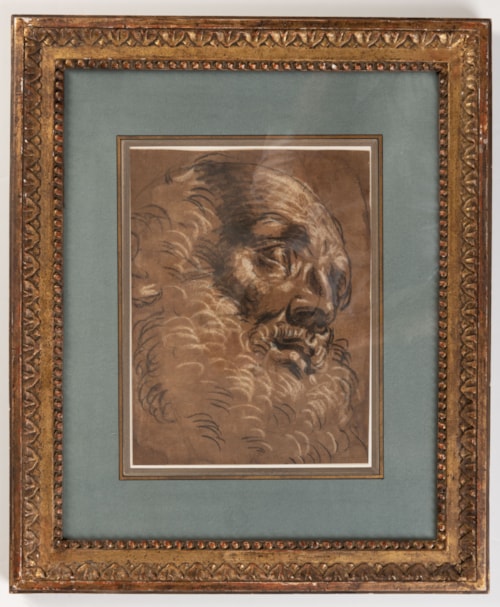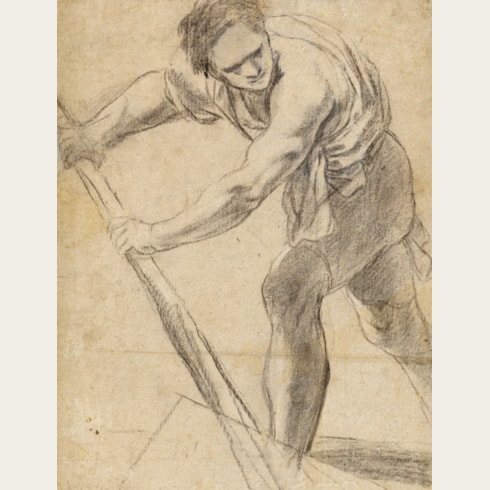Giacomo CAVEDONE
(Sassuolo 1577 - Bologne 1660)
The Head of a Bearded Man
Charcoal, heightened with white chalk, on paper washed a light brown.
Made up at the lower left and right and upper right corners.
Numbered 18. and inscribed Domenichino / St. Gerolamo on the reverse of the old mount. Inscribed Original sketch of the Head of St. Gerome for his picture of the / Communion, now at Rome – by Domenichino and numbered 16 on the album page on which this drawing was formerly mounted.
271 x 203 mm. (10 5/8 x 8 in.)
Made up at the lower left and right and upper right corners.
Numbered 18. and inscribed Domenichino / St. Gerolamo on the reverse of the old mount. Inscribed Original sketch of the Head of St. Gerome for his picture of the / Communion, now at Rome – by Domenichino and numbered 16 on the album page on which this drawing was formerly mounted.
271 x 203 mm. (10 5/8 x 8 in.)
Previously attributed to Domenichino, this drawing cannot be related to any surviving work by Giacomo Cavedone, although the facial type and morphology of the model is entirely typical of the artist. A similar drawing of a bearded man, of identical technique, was formerly in the Horvitz collection; this was a study for the head of Saint Joseph in Cavedone’s altarpiece of the Adoration of the Magi of 1614, in the Bolognese church of San Paolo Maggiore. The present sheet may further be compared with several examples from a group of fifty drawings of male and female heads in the Royal Library at Windsor Castle. The Windsor drawings by Cavedone were assembled in an album, described in a late 18th century inventory of King George III’s collection as ‘Teste di Cavedone. Although slight yet drawn with great fire and spirit, most as large as life.’ Other drawings by Cavedone of this type are in the Art Institute of Chicago and the Cleveland Museum of Art.
Laura Giles has kindly pointed out that a drawing of the same head in an identical pose, larger than the present sheet and showing more of the neck and head, is in the Royal Collection at Windsor Castle.
Laura Giles has kindly pointed out that a drawing of the same head in an identical pose, larger than the present sheet and showing more of the neck and head, is in the Royal Collection at Windsor Castle.
Giacomo Cavedone entered the Carracci academy in Bologna in 1591, studying initially with Annibale Carracci. After Annibale’s departure for Rome in 1595, Cavedone remained in Bologna, becoming one of Ludovico Carracci’s chief assistants. He continued to work with Ludovico until the latter’s death in 1619, collaborating on such projects as the decoration of San Michele in Bosco. Cavedone’s first known independent painting is a Saint Stephen in Glory of 1601, today in the Galleria Estense in Modena. In 1609 he travelled to Rome, where he assisted Guido Reni on the decoration of the Cappella Paolina in Monte Cavallo. The influence of this Roman sojourn, and particularly his exposure to the work of Caravaggio, is reflected in such paintings as The Baptism of Christ of c.1611-1612, in the church of San Pietro Martire in Modena.
Cavedone painted several monumental altarpieces for churches in and around Bologna, and the effects of a trip to Venice between 1612 and 1613 can be seen in the painterly richness of works such as the large Sant’Alò altarpiece of 1614, now in the Pinacoteca Nazionale in Bologna. Having inherited the title of caposindaco of the Accademia degli Incamminati after the death of Ludovico Carracci, Cavedone spent the next few years of his career busy with commissions for frescoes, altarpieces and easel pictures. However, injuries sustained as a result of a fall from scaffolding in 1623, together with the loss of his wife and children to the plague of 1630, seems to have ended his career prematurely, and he produced very little work in the thirty years remaining before his death.
Cavedone’s drawings display a distinctive combination of Venetian and Bolognese elements, with the particular influence of the draughtsmanship of Titian on the one hand and Ludovico Carracci on the other. His drawings may be divided into three main groups - compositional sketches, figure and drapery studies, and large studies of individual heads - and approximately half of his surviving drawings may be related to extant paintings. While his composition drawings were generally drawn in pen and ink wash, for figure and head studies he tended to use either a soft black chalk, usually applied on blue paper, or charcoal heightened with white chalk on light brown (and sometimes oiled) paper. (Cavedone’s drawings of this latter type were to be a strong influence on Guercino’s draughtsmanship.) The largest and most important single group of drawings by Cavedone, numbering just under seventy sheets, is in the collection of the Royal Library at Windsor Castle.
Provenance
From an album of miscellaneous, mostly Bolognese drawings, assembled by a certain Mr. Yeates in Italy in 1823 (according to an inscription on the first page of the album)
Anonymous sale, London, Sotheby’s Olympia, 11 December 2002, lot 30
Jean-Luc Baroni Ltd., London, in 2003
Private collection.
Anonymous sale, London, Sotheby’s Olympia, 11 December 2002, lot 30
Jean-Luc Baroni Ltd., London, in 2003
Private collection.
Exhibition
New York and London, Jean-Luc Baroni Ltd., Master Drawings, 2003, no.14.






